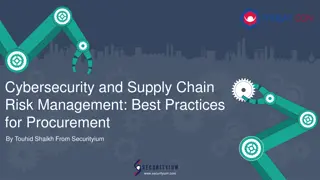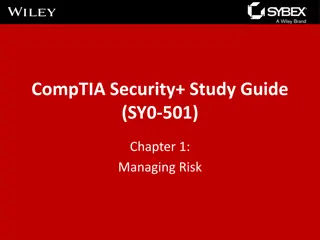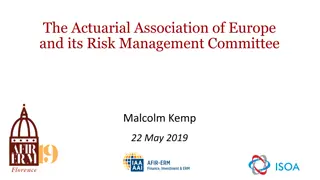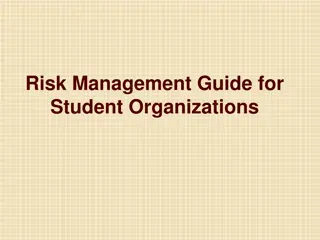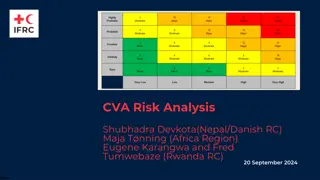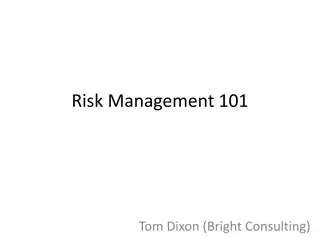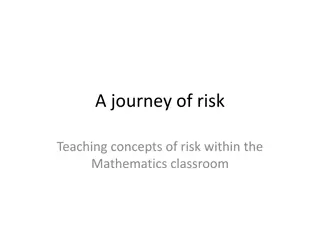Comprehensive Guide to Risk Management Processes
Explore the essential aspects of risk management in Chapter 7, covering the risk management process, benefits, risk event graph, and step-by-step procedures for risk identification and assessment. Learn how proactive risk management reduces surprises, enhances control, and improves project performance within constraints.
Download Presentation

Please find below an Image/Link to download the presentation.
The content on the website is provided AS IS for your information and personal use only. It may not be sold, licensed, or shared on other websites without obtaining consent from the author. Download presentation by click this link. If you encounter any issues during the download, it is possible that the publisher has removed the file from their server.
E N D
Presentation Transcript
Managing Risk Chapter 7
Risk Management Process Risk An uncertain event that, if it occurs, has a positive or negative effect on project objectives Risk Management A proactive attempt to recognize and manage internal events and external threats that affect the likelihood of a project s success What can go wrong (risk event) How to minimize the risk event s impact (consequences) What can be done before an event occurs (anticipation) What to do when an event occurs (contingency plans)
The Risk Event Graph FIGURE 7.1
Risk Managements Benefits A proactive rather than reactive approach Reduces surprises and negative consequences Prepares the project manager to take advantage of appropriate risks Provides better control over the future Improves chances of reaching project performance objectives within budget and on time
The Risk Management Process FIGURE 7.2
Managing Risk Step 1: Risk Identification Generate a list of possible risks through brainstorming, problem identification and risk profiling. Macro risks first, then specific events Step 2: Risk Assessment Scenario analysis Risk assessment matrix Failure Mode and Effects Analysis (FMEA) Probability analysis Decision trees, NPV, and PERT Semiquantitative scenario analysis
Partial Risk Profile for Product Development Project FIGURE 7.3
Risk Assessment Form FIGURE 7.4
Risk Severity Matrix FIGURE 7.5
Managing Risk (contd) Step 3: Risk Response Development Mitigating Risk Reducing the likelihood an adverse event will occur Reducing impact of adverse event Transferring Risk Paying a premium to pass the risk to another party Avoiding Risk Changing the project plan to eliminate the risk or condition Sharing Risk Allocating risk to different parties Retaining Risk Making a conscious decision to accept the risk
Contingency Planning Contingency Plan An alternative plan that will be used if a possible foreseen risk event actually occurs A plan of actions that will reduce or mitigate the negative impact (consequences) of a risk event Risks of Not Having a Contingency Plan Having no plan may slow managerial response Decisions made under pressure can be potentially dangerous and costly
Risk Response Matrix FIGURE 7.7
Risk and Contingency Planning Technical Risks Backup strategies if chosen technology fails Assessing whether technical uncertainties can be resolved Schedule Risks Use of slack increases the risk of a late project finish Imposed duration dates (absolute project finish date) Compression of project schedules due to a shortened project duration date
Risk and Contingency Planning (contd) Costs Risks Time/cost dependency links: costs increase when problems take longer to solve than expected. Deciding to use the schedule to solve cash flow problems should be avoided. Price protection risks (a rise in input costs) increase if the duration of a project is increased. Funding Risks Changes in the supply of funds for the project can dramatically affect the likelihood of implementation or successful completion of a project.
Contingency Funding and Time Buffers Contingency Funds Funds to cover project risks identified and unknown Size of funds reflects overall risk of a project Budget reserves Are linked to the identified risks of specific work packages Management reserves Are large funds to be used to cover major unforeseen risks (e.g., change in project scope) of the total project Time Buffers Amounts of time used to compensate for unplanned delays in the project schedule
Contingency Fund Estimate (000s) TABLE 7.1
Managing Risk (contd) Step 4: Risk Response Control Risk control Execution of the risk response strategy Monitoring of triggering events Initiating contingency plans Watching for new risks Establishing a Change Management System Monitoring, tracking, and reporting risk Fostering an open organization environment Repeating risk identification/assessment exercises Assigning and documenting responsibility for managing risk
Change Management Control Sources of Change Project scope changes Implementation of contingency plans Improvement changes
Change Management Control The Change Control Process Identify proposed changes. List expected effects of proposed changes on schedule and budget. Review, evaluate, and approve or disapprove of changes formally. Negotiate and resolve conflicts of change, condition, and cost. Communicate changes to parties affected. Assign responsibility for implementing change. Adjust master schedule and budget. Track all changes that are to be implemented.
The Change Control Process FIGURE 7.8
Benefits of a Change Control System Inconsequential changes are discouraged by the formal process. Costs of changes are maintained in a log. Integrity of the WBS and performance measures is maintained. Allocation and use of budget and management reserve funds are tracked. Responsibility for implementation is clarified. Effect of changes is visible to all parties involved. Implementation of change is monitored. Scope changes will be quickly reflected in baseline and performance measures. 1. 2. 3. 4. 5. 6. 7. 8.
Change Request Form FIGURE 7.9
Change Request Log FIGURE 7.10
Key Terms Avoiding risk Budget reserve Change management system Contingency plan Management reserve Mitigating risk Risk Risk profile Risk Breakdown Structure Risk severity matrix Scenario analysis Sharing risk Time Buffer Transferring risk
PERT and PERT Simulation Chapter 7 Appendix
PERTProgram Evaluation Review Technique Assumes each activity duration has a range that statistically follows a beta distribution. PERT uses three time estimates for each activity: optimistic, pessimistic, and a weighted average to represent activity durations. Knowing the weighted average and variances for each activity allows the project planner to compute the probability of meeting different project durations.
Activity and Project Frequency Distributions FIGURE A7.1
Activity Time Calculations The weighted average activity time is computed by the following formula:
Activity Time Calculations (contd) The variability in the activity time estimates is approximated by the following equations: The standard deviation for the activity: The standard deviation for the project: Note the standard deviation of the activity is squared in this equation; this is also called variance. This sum includes only activities on the critical path(s) or path being reviewed.
Probability of Completing the Project The equation below is used to compute the Z value found in statistical tables (Z = number of standard deviations from the mean), which, in turn, tells the probability of completing the project in the time specified. (7.4)
Hypothetical Network FIGURE A7.2
Hypothetical Network (contd) FIGURE A7.2 (cont d)
Possible Project Duration FIGURE A7.3
Z Values TABLE A7.3








